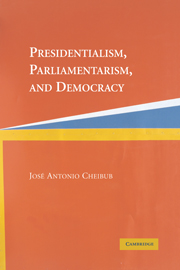Book contents
- Frontmatter
- Contents
- List of Figures and Tables
- Acknowledgments
- 1 INTRODUCTION
- 2 PRESIDENTIAL, PARLIAMENTARY, AND MIXED DEMOCRACIES
- 3 ARE THE INCENTIVES FOR COALITION FORMATION DIFFERENT IN PARLIAMENTARY AND PRESIDENTIAL DEMOCRACIES?
- 4 ARE COALITIONS RARE IN PRESIDENTIAL DEMOCRACIES?
- 5 PARTY DISCIPLINE AND FORM OF GOVERNMENT
- 6 WHAT MAKES PRESIDENTIAL DEMOCRACIES FRAGILE?
- 7 CONCLUSION
- Appendix: Definition and Sources of Variables
- References
- Index
- Cambridge Studies in Comparative Politics
1 - INTRODUCTION
Published online by Cambridge University Press: 05 June 2012
- Frontmatter
- Contents
- List of Figures and Tables
- Acknowledgments
- 1 INTRODUCTION
- 2 PRESIDENTIAL, PARLIAMENTARY, AND MIXED DEMOCRACIES
- 3 ARE THE INCENTIVES FOR COALITION FORMATION DIFFERENT IN PARLIAMENTARY AND PRESIDENTIAL DEMOCRACIES?
- 4 ARE COALITIONS RARE IN PRESIDENTIAL DEMOCRACIES?
- 5 PARTY DISCIPLINE AND FORM OF GOVERNMENT
- 6 WHAT MAKES PRESIDENTIAL DEMOCRACIES FRAGILE?
- 7 CONCLUSION
- Appendix: Definition and Sources of Variables
- References
- Index
- Cambridge Studies in Comparative Politics
Summary
What difference does the form of government make for the chances that a democratic regime will survive? There are two basic forms of democratic governments. In one the government depends on the confidence of the legislature in order to exist. In the other the government, or more precisely its head, serves for a fixed term; thus the executive and the legislature are independent from one another. In systems of the former type, which are parliamentary, a legislative majority may remove the government from office – either by passing a vote of no confidence in the government or by rejecting a vote of confidence initiated by the government. When this happens, one of two things takes place: either a new government is formed on the basis of the existing distribution of legislative seats or, if this proves impossible, new elections are held in the hope that the new seat distribution will be such that a government will become viable (i.e., will not be immediately subject to a vote of no confidence from the legislative majority). In systems of the latter type, which are presidential, no such mechanism exists for removing the government. The head of the government may or may not be chosen by the legislative body, but once chosen he or she serves a fixed term in office: in presidential systems, the head of the government cannot be removed from office even if he or she favors policies opposed by the legislative majority.
- Type
- Chapter
- Information
- Presidentialism, Parliamentarism, and Democracy , pp. 1 - 25Publisher: Cambridge University PressPrint publication year: 2006

